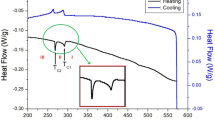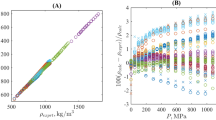Abstract
THE first part of Brynestad's comments on our communication1 is concerned with the 1-component system: two solids, liquid and vapour. We mentioned this in our original paper2 only in passing, since we could not cite any example for discussion. Brynestad's comment raises an issue which we did not consider, namely, if such a system existed, whether the relative amounts of the two solid phases present would be in a fixed ratio. Brynestad, following Ricci3, cites the case of d- and l-sodium chlorate. Before we turn to this interesting case, let us first examine Brynestad's analysis of a system which we did discuss in our original article, namely, a 2-component, five-phase system. We cited a number of ‘near misses’ such as the system mercury (m.p. − 38.9°) and diethylaniline (− 38.8°) and said that deuteration of the organic moiety in this and in other examples of ‘near misses’ could conceivably bring the triple points of the two components into exact coincidence. We interpreted Brynestad's original remarks4 to mean that the chance of such a system existing was comparable to the chance of failure of the second law of thermodynamics. We see now that Brynestad did not mean this and that he does not rule out the possibility of such systems existing. He goes on to say that ‘most probably the two solids would occur in fixed proportions’. We do not believe this to be correct for reasons given as follows. Moreover, Brynestad claims that the system would be ‘a normal 4-phase system’. To say that solid mercury and solid diethylaniline are thermo-dynamically the same phase is to so alter the meaning of ‘phase’ as to derive it of any further value. One can easily trace the reasoning leading up to this conclusion: the phase rule is true; the mercury system + diethylaniline (for example) would, if considered to have five phases, imply a negative degree of freedom; negative degrees of freedom are not possible; therefore, at least two of the phases must be thermodynamically the same. To us it makes more sense to concede that negative degrees of freedom are possible; their existence is easily explained and the phase rule is not violated. We turn now to the system: d-NaClO3(c) + l-NaClO3(c) + melt + vapour.
This is a preview of subscription content, access via your institution
Access options
Subscribe to this journal
Receive 51 print issues and online access
$199.00 per year
only $3.90 per issue
Buy this article
- Purchase on SpringerLink
- Instant access to full article PDF
Prices may be subject to local taxes which are calculated during checkout
Similar content being viewed by others
References
Halliwell, H. F., and Nyburg, S. C., Nature, 200, 670 (1963).
Halliwell, H. F., and Nyburg, S. C., J. Phys. Chem., 64, 855 (1960).
Ricci, J. E., The Phase Rule, 4 (van Nostrand, Co., 1951).
Brynestad, J., Z. Phys. Chem., 36, 356 (1963).
Author information
Authors and Affiliations
Rights and permissions
About this article
Cite this article
HALLIWELL, H., NYBURG, S. Negative Degrees of Freedom and the Phase Rule. Nature 201, 1118 (1964). https://doi.org/10.1038/2011118a0
Issue date:
DOI: https://doi.org/10.1038/2011118a0



